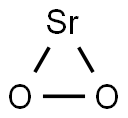Uses
Strontium dioxide (SrO2) can cause fires or explode when heated and in
contact with organic substances. It is used as both a reducing agent and an oxidizing agent.
Chemical Properties
white to off-white powder
Chemical Properties
Strontium peroxide is a lightcolored solid of good thermal stability. Commercial strontium peroxide contains about 85% SrO2 and 10% active oxygen.
Uses
Strontium peroxide or strontium dioxide (SrO2) can cause fires or explode when heated and in contact with organic substances. It is used as both a reducing agent and an oxidizing agent.
Uses
The only substantial application for this compound is in pyrotechnics. Strontium peroxide produces a red color in flames.
Uses
Strontium Peroxide is
an oxidizing agent that is used for bleaching. It has
also been used in some pyrotechnic displays to provide a vivid-red color.
Preparation
Like the other alkaline earth peroxides, it can be
prepared by reaction of the nitrate and sodium peroxide
in a cold solution:
Sr(NO3)2+ Na2O2+xH2O
SrO2·xH2O+2NaNO3
The hydrated form is usually the octahydrate. If the
anhydrate is desired, the hydrated peroxide is dried
and then sintered at 350°C for 10 min or less:
SrO2·xH2O+ heat→SrO+SrO2+H2O
General Description
A white powder. Insoluble in water and slowly decomposed by water. Noncombustible, but accelerates the burning of combustible material.
Air & Water Reactions
Insoluble in water and slowly decomposed by water.
Reactivity Profile
Strontium peroxide may explode from friction, heat or contamination. Accelerates burning when involved in a fire. May ignite combustibles (wood, paper, oil, clothing, etc.). If the combustible material is finely divided the mixture may be explosive.
Health Hazard
TOXIC; inhalation, ingestion or contact (skin, eyes) with vapors, dusts or substance may cause severe injury, burns or death. Fire may produce irritating and/or toxic gases. Toxic fumes or dust may accumulate in confined areas (basement, tanks, hopper/tank cars, etc.). Runoff from fire control or dilution water may cause pollution.
Fire Hazard
May explode from friction, heat or contamination. These substances will accelerate burning when involved in a fire. May ignite combustibles (wood, paper, oil, clothing, etc.). Some will react explosively with hydrocarbons (fuels). Containers may explode when heated. Runoff may create fire or explosion hazard.
Flammability and Explosibility
Not classified
reaction suitability
reagent type: oxidant
Safety Profile
A powerful oxidizer. A skin, eye, and mucous membrane irritant. Mixtures with organic materials readily ignite with friction or on contact with moisture. See also PEROXIDES and STRONTIUM COMPOUNDS.



